Knee pain without a specific injury is more common than many realize, especially in active individuals and adolescents. Studies show an annual prevalence of patellofemoral pain reaching 22.7% in the general population and up to 28.9% in adolescents. Among amateur runners, incidence rates can reach 1,080.5 cases per 1,000 person-years, while among military recruits, rates range from 9.7 to 571.4 per 1,000 person-years. Understanding what can cause knee pain without injury is key to managing symptoms early, maintaining mobility, and avoiding chronic discomfort.
Key Takeaways
-
Knee pain without injury can stem from various conditions, including inflammatory diseases, degenerative joint diseases, fluid accumulation, and structural misalignments.
-
Identifying underlying causes such as bursitis, tendinitis, osteoarthritis, and gout is essential for effective management and relief of knee pain.
-
Preventive measures, like maintaining a healthy weight, engaging in low-impact physical activities, and using knee braces, can significantly reduce knee pain and improve joint health.
Why Does My Knee Hurt Without an Injury?
Knee pain without a specific injury is surprisingly common, especially among older adults. According to a significant study using data from over 8,000 Korean adults aged 50 and above, nearly 21% reported chronic knee pain, even when no recent injury had occurred. In fact, 77.8% of adults with osteoarthritis experienced some level of knee pain, and more than 12% described it as continuous.
This type of pain is often linked to underlying conditions such as osteoarthritis, joint inflammation (such as synovitis), or mechanical imbalances in the leg and hip. Sedentary behavior is also a significant contributor.
Sitting for over 10 hours a day was associated with a 28% higher risk of chronic knee pain. Obesity further increases the risk, with obese individuals being more than three times as likely to report knee pain compared to those with a healthy BMI.
Knee pain that develops gradually or without a clear cause is not always due to sports injuries or sudden trauma. It may result from age-related cartilage wear, poor posture, weak supporting muscles, or reduced mobility. Many individuals also experience reduced physical function and overall quality of life as a result.
So what’s behind knee pain when there’s no injury? Below are the top 5 reasons that could be contributing to your discomfort, and understanding them is the first step toward effective relief.
1. Inflammatory Conditions
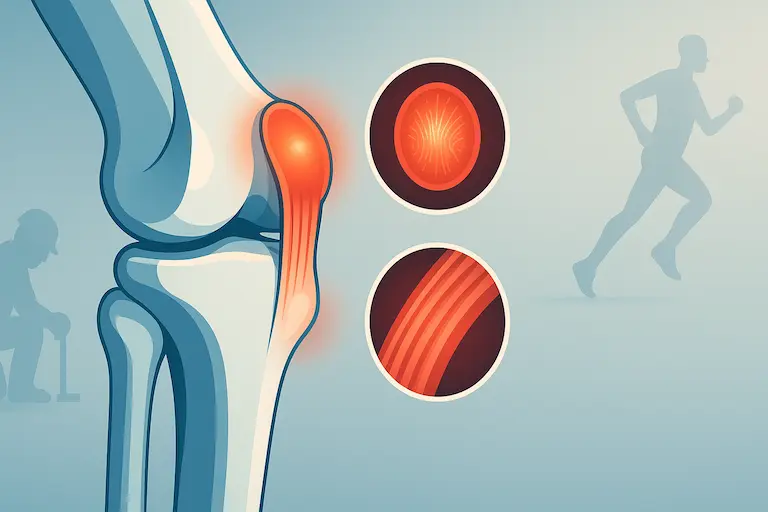
If your knee pain develops gradually and without an apparent injury, inflammation is often to blame. These conditions can irritate soft tissues or the joint lining itself, leading to persistent pain, stiffness, and swelling. They are especially common in older adults, physically active individuals, and people in jobs that involve kneeling or repetitive leg movement.
Two of the most common inflammation-related causes are rheumatoid arthritis and bursitis, both of which can significantly impact knee function if not addressed early.
Bursitis
Knee bursitis involves inflammation of small, fluid-filled sacs called bursae that cushion and reduce friction in the knee joint. Repetitive kneeling or pressure on the knees can inflame these sacs, leading to tenderness and visible swelling.
A large French study involving 3,710 workers found that the prevalence of knee bursitis was 0.6% in men and 0.2% in women, with higher rates in construction (2.3%) and food processing (1.4%) workers. The condition was most common among blue-collar workers with heavy workloads and prolonged kneeling.
Common symptoms include pain in the front of the knee, difficulty kneeling, and swelling. Most cases can be treated with rest, ice, and physical therapy, while more severe inflammation may require drainage of fluid or corticosteroid injections. Early management helps prevent chronic pain and joint stiffness.
Tendinitis
Knee tendinitis occurs when the tendons connecting muscles to bones become inflamed, typically due to overuse or repetitive strain. It often causes a dull ache around the knee that worsens with movement. Athletes and physically active individuals are particularly prone to this condition, especially when training intensity increases suddenly.
Treatment typically involves rest, ice, anti-inflammatory medications, and physical therapy to strengthen surrounding muscles and improve flexibility. Addressing tendinitis early can prevent chronic inflammation and support long-term knee health.
2. Degenerative Joint Diseases
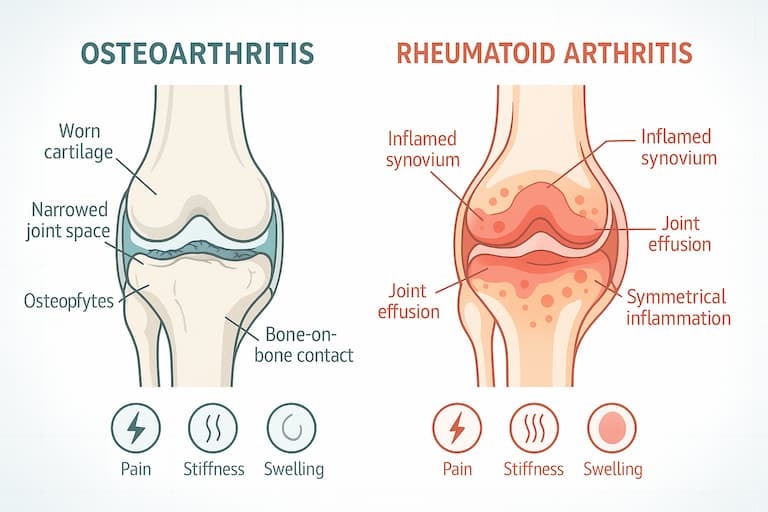
Knee pain without injury is often rooted in long-term joint deterioration. Two primary culprits are osteoarthritis (OA) and rheumatoid arthritis (RA). Both conditions gradually damage the knee’s internal structures and are leading causes of chronic knee discomfort, stiffness, and reduced mobility.
Understanding their prevalence and clinical features can help you take informed steps toward treatment and joint preservation.
Osteoarthritis
Osteoarthritis is the most prevalent type of arthritis, affecting approximately 32.5 million adults in the United States. It typically results from long-term wear and tear on the knee joint. Over time, the protective cartilage deteriorates, causing the bones to rub against each other. This friction leads to pain, swelling, stiffness, and reduced range of motion. People with OA often notice that symptoms worsen with activity and ease with rest.
The burden of OA extends beyond personal discomfort. According to the CDC, 1 in 5 U.S. adults (53.2 million people) has some form of arthritis, with OA being the most common. As the condition progresses, it can significantly affect a person’s ability to work or stay active, especially among older adults.
Treatment for osteoarthritis focuses on managing symptoms and preserving joint function. Physical therapy, weight management, and anti-inflammatory medications are often recommended. In advanced cases, surgical intervention such as joint replacement may be necessary to restore mobility.
Rheumatoid Arthritis
Rheumatoid arthritis, while less common than OA, is another primary source of knee pain. It’s an autoimmune disease in which the body’s immune system mistakenly attacks the synovium, the lining of the joints. This immune response triggers chronic inflammation, leading to pain, swelling, and eventual joint damage.
RA affects an estimated 1 to 2 percent of the global population. In the United States, the average annual incidence is about 70 per 100,000 people, with women being two to three times more likely to develop RA than men. The risk increases with age, particularly among women over 55, where the prevalence approaches 5 percent.
Unlike OA, which is mechanical in nature, RA’s inflammatory process affects the body systemically. Many patients report morning stiffness lasting more than 30 minutes, pain in both knees, and general fatigue. Early diagnosis is critical, as untreated RA can lead to irreversible joint deformities and significant disability.
Management of RA typically includes immunosuppressive medications such as DMARDs and biologic agents to slow disease progression. Physical therapy and lifestyle modifications also play an essential role in preserving joint function and quality of life.
3. Fluid Accumulation Issues
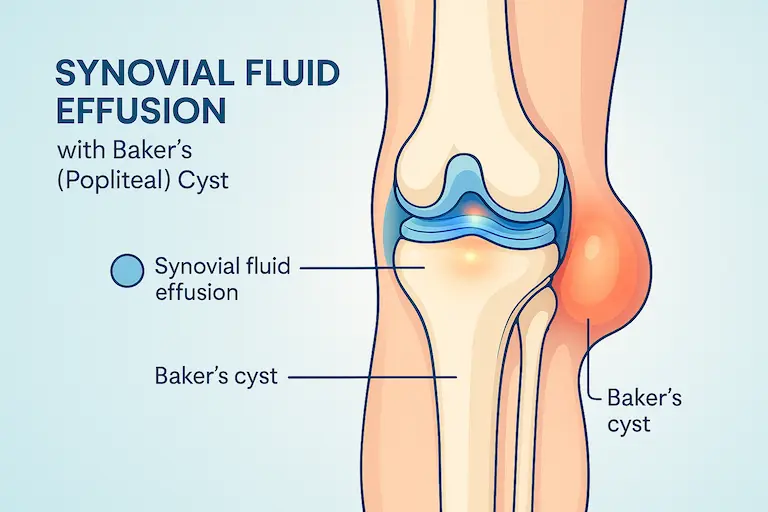
Fluid accumulation in the knee can lead to knee pain even in the absence of injury. It is a common cause of discomfort in this area. This condition can lead to discomfort and restrict motion, significantly impacting daily activities. Fluid build-up in the knee joint, known as effusion, can result from various knee conditions and injuries.
Baker’s cysts and popliteal cysts are two types of fluid-filled sacs that can form in the knee area, leading to swelling and limited movement. These cysts often develop due to underlying knee joint disorders or excess synovial fluid.
Knowing about these fluid accumulation issues helps manage knee pain effectively.
Baker's Cyst
A Baker’s cyst is a fluid-filled swelling behind the knee joint, often associated with inflammatory joint conditions. It results when synovial fluid escapes from the knee capsule and collects in the popliteal bursa. This may happen due to cartilage damage, torn ligaments, or chronic joint inflammation. Patients with this condition often feel pain or tightness behind the knee, especially when extending the leg.
In one musculoskeletal ultrasound study involving 1,120 patients, 12.9% were diagnosed with Baker’s cysts. The most frequent causes were osteoarthritis (50.6%), rheumatoid arthritis (20.6%), and gout (13.9%). Interestingly, ruptured cysts were more commonly linked to inflammatory conditions.
To treat knee pain caused by a Baker’s cyst, an effective treatment plan is essential. This may include fluid drainage, anti-inflammatory medications, and physical therapy. In more persistent cases, corticosteroid injections or surgical intervention may be required to alleviate pain and restore normal function.
Popliteal Cyst
Popliteal cysts are often used interchangeably with Baker’s cysts but refer more specifically to the anatomic location behind the knee. These cysts develop due to increased pressure and fluid inside the joint space and can lead to swelling, stiffness, and difficulty walking.
If your knee hurts and there's no apparent injury, a popliteal cyst might be to blame, especially if accompanied by a bulge behind the knee. These cysts can stem from causes of knee pain such as arthritis, gout, or overuse.
Managing a popliteal cyst typically involves rest, anti-inflammatory treatment, and physical therapy. Addressing the underlying cause helps alleviate pain and improve range of motion, reducing the risk of worsening symptoms or developing further complications, such as cartilage damage.
4. Structural Misalignments
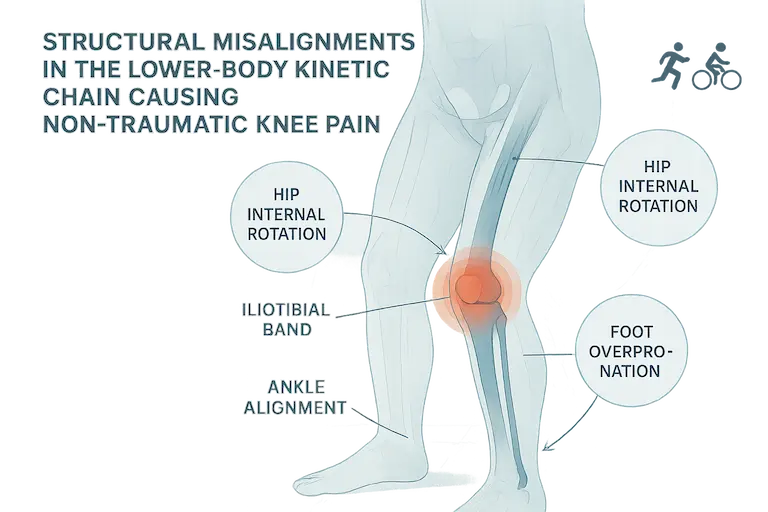
When your knee hurts without an apparent injury, the problem might originate elsewhere in your body. Structural misalignments can disrupt movement patterns and place uneven stress on the knees, resulting in inflammation, discomfort, and long-term joint strain. This is a common but often undiagnosed cause of knee injury, especially among active individuals and athletes.
Misalignments in the hips, feet, or spine can throw off posture and gait, forcing the knees to absorb unnatural pressure. Addressing these imbalances can alleviate pain, improve mobility, and prevent chronic joint degeneration.
Let’s take a closer look at two of the most frequent structural issues linked to knee pain without trauma: iliotibial band syndrome and misalignments in the hip, foot, or ankle.
Iliotibial Band Syndrome
ITBS is one of the most common overuse injuries in runners and cyclists. It occurs when the iliotibial band, a thick band of connective tissue running from the hip to the outer knee, becomes tight or inflamed. This friction at the outer knee causes localized pain, especially during repetitive movements such as running, cycling, or climbing stairs.
-
Studies have shown that ITBS accounts for up to 22% of lower extremity injuries in runners and 12% of all running-related overuse injuries.
-
One investigation found a prevalence of ITBS as high as 15% in long-distance runners, highlighting the mechanical stress the band places on the lateral knee during high-repetition motion.
Typical symptoms include sharp pain on the outside of the knee during or after activity. Left untreated, ITBS can limit mobility and lead to compensatory movement patterns that stress other joints.
Treatment options include:
-
Rest and activity modification
-
Ice and anti-inflammatory therapy
-
Stretching and foam rolling
-
Physical therapy focused on hip strength and mobility
-
Gait retraining and footwear correction
Addressing ITBS early with proper treatment is crucial to prevent chronic irritation and to treat knee pain at its root.
Hip, Foot, or Ankle Problems
Structural issues in the hip, foot, or ankle are also common causes of knee pain. When one area is misaligned, the entire kinetic chain is affected, altering how weight is distributed through the legs and knees.
For example:
-
A flat foot (overpronation) causes inward collapse of the leg, straining the knee.
-
A misaligned or weak hip can increase rotational forces at the knee.
These misalignments are particularly relevant for active individuals. A 2023 study reported that abnormal foot posture was present in 31.3% of people with anterior knee pain, reinforcing the interconnectedness of lower-body alignment.
Symptoms may include diffuse discomfort, swelling, or difficulty maintaining balance. If your knee hurts even without a sudden injury, and movement feels "off," this may be a sign of misalignment.
Effective management may involve:
-
Targeted physical therapy for hip or foot alignment
-
Custom orthotics
-
Gait analysis and correction
-
Strength training for the surrounding muscles
-
Proper footwear with arch support
Correcting biomechanical dysfunction can alleviate pain, prevent cartilage damage, and support long-term joint health.
5. Systemic Health Conditions
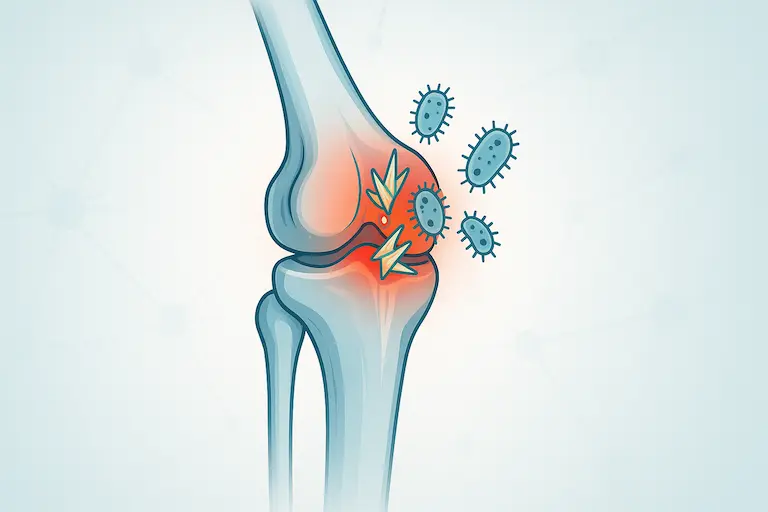
Not all knee pain comes from a visible injury. In many cases, it can be traced back to systemic health conditions that affect complex joints throughout the body.
These conditions often trigger inflammation or swelling, leading to knee pain even when there's been no recent trauma. Two of the most common causes of knee discomfort in this category are gout and infections.
Gout
Gout is an autoimmune condition characterized by elevated blood uric acid levels. When these levels rise, sharp crystals can form inside joints, especially the knee, causing pain, redness, and intense swelling. It's often described as a burning or stabbing sensation that can severely restrict movement.
About 8.3 million Americans live with gout, and the knee joint is among the most commonly affected complex joints. A gout flare may develop overnight and cause:
-
Sudden and severe pain in the knee
-
Noticeable swelling and warmth
-
Limited mobility that can restrict movement
-
Hypersensitivity to even light touch
Gout is more than temporary discomfort. Repeated flares can cause joint damage if left untreated. Managing uric acid through medication, hydration, and lifestyle changes, including reducing red meat and alcohol, is critical.
Gout doesn’t typically resolve independently. A proactive plan guided by your doctor can help you manage flares and maintain an active lifestyle.
Infection
Knee infections, also known as septic arthritis, are serious and need immediate medical care. They often develop when bacteria enter the joint, either through an injury, surgery, or bloodstream. The result is rapid inflammation, pain, and swelling, often without warning.
Though relatively rare, occurring in 4 to 10 out of every 100,000 people annually, infections can lead to joint damage or disability if not caught early. People with diabetes, weakened immune systems, or prior knee surgeries are more at risk.
Typical signs of an infected knee include:
-
Persistent swelling and intense pain
-
Redness and heat around the joint
-
Difficulty moving the knee or putting weight on it
-
Fever or chills
Treatment may include antibiotics, joint drainage, and physical rehabilitation. Because infections can mimic other causes of knee pain, identifying the underlying cause early ensures faster recovery and prevents further joint damage.
How Can You Prevent and Manage Knee Pain?
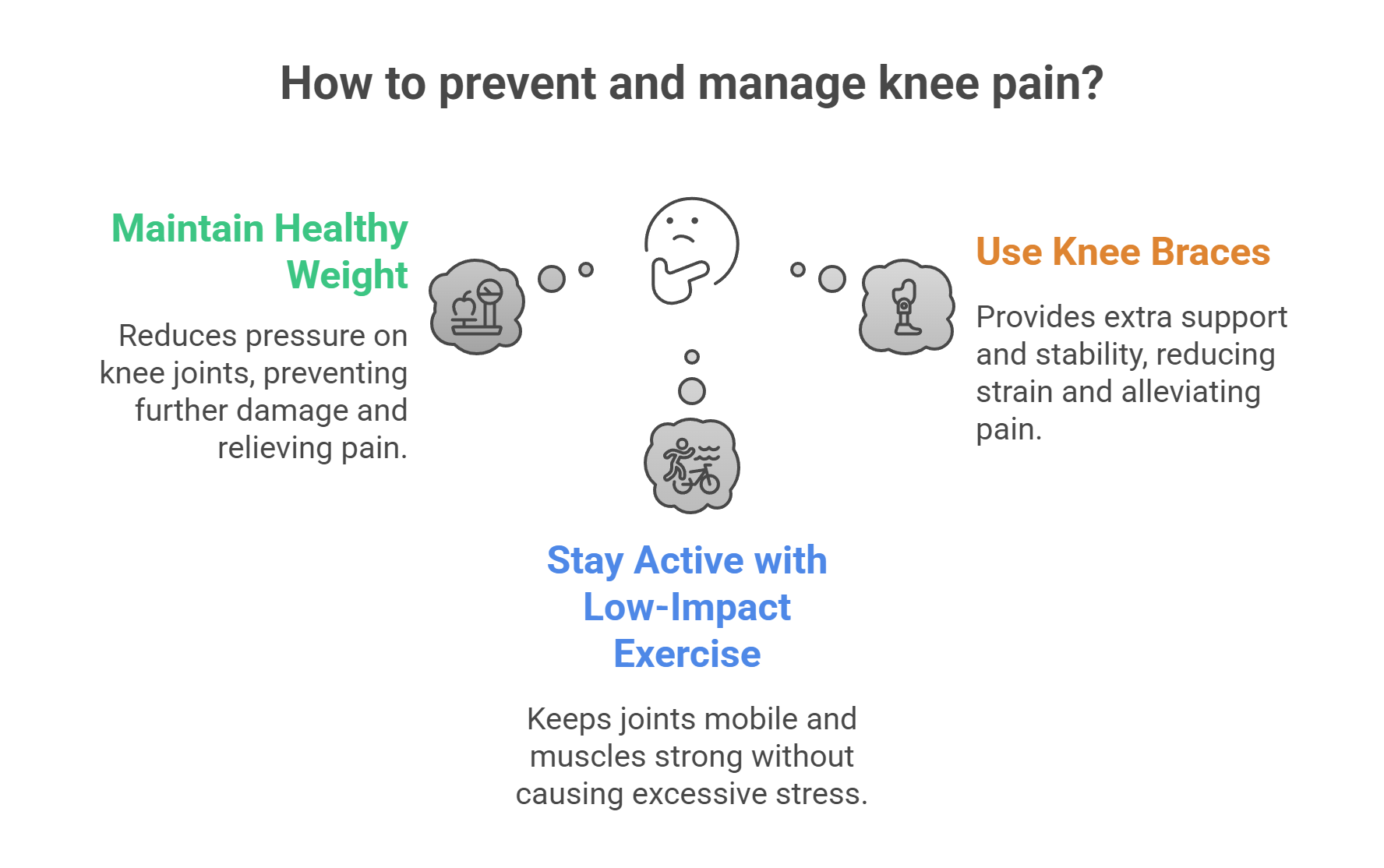
Preventing and managing knee pain requires a thoughtful balance of healthy habits, early intervention, and supportive tools.
Here are three effective strategies to help you treat knee pain and support your knees for the long term.
Maintain a Healthy Weight
Excess weight puts considerable prolonged pressure on your knee joints, increasing your risk of joint pain and conditions like osteoarthritis. Research shows that for every 10 pounds lost, the force on your knees during daily movement is reduced by up to 40 pounds. This not only helps relieve existing pain but also prevents further joint damage.
A balanced diet and regular movement support weight management, helping reduce strain on your knees and improve overall mobility.
Stay Active with Low-Impact Exercise
Consistent physical activity keeps your joints mobile and your surrounding muscles strong. Low-impact activities like walking, swimming, or cycling can alleviate pain and improve flexibility without placing unnecessary stress on the knees.
Unlike high-impact sports, which may increase the risk of repetitive movements leading to cartilage damage or torn ligaments, low-impact workouts preserve joint integrity and promote circulation, both of which are important for healing and controlling inflammation.
Use Knee Braces for Extra Support
Knee braces can play an essential role in both treating and preventing knee pain. For those recovering from an injury, managing a condition like arthritis, or simply seeking added joint support during exercise, braces help stabilize the knee, reduce strain, and alleviate pain during movement.
The Anaconda Fightwear Knee Brace is designed to provide targeted compression and support without restricting mobility. Whether you’re managing flare-ups, training, or looking for everyday stability, it can be an excellent addition to your knee pain management plan.
Looking for relief that moves with you? Try the Anaconda Fightwear Knee Brace for everyday support, whether you're recovering or staying active. Your knees will thank you.
When Should You See a Doctor for Knee Pain
Not all knee pain requires a trip to the doctor, but sure signs should never be ignored.
Seek immediate medical attention if you experience:
-
Intense or sharp knee pain
-
Sudden or significant swelling
-
Persistent knee pain
-
Inability to bear weight on the affected leg
If your knee pain persists for more than a few weeks despite rest, ice, or over-the-counter treatments, or if it interferes with your sleep or daily activities, consult a healthcare provider as you need specialized care. These could be signs of an undiagnosed knee injury, joint damage, or other underlying issues.
Early diagnosis improves outcomes and helps prevent long-term complications. Don’t wait; addressing serious symptoms promptly ensures faster healing and protects your joint health.
Final Thoughts
Knee pain without injury can stem from multiple sources, including inflammatory diseases, degenerative conditions, fluid build-up, alignment issues, and systemic health problems. Identifying the root cause is key to finding relief and preventing further joint damage.
Proactive steps like maintaining a healthy weight, staying active with low-impact movement, and supporting your knees during activity can make a significant difference. If pain persists or worsens, don’t hesitate to consult a healthcare professional for proper treatment.
For extra support, consider using a well-designed knee brace. The Anaconda Fightwear Knee Brace provides targeted compression and joint stability, making it a great addition to your recovery and prevention plan.
Frequently Asked Questions
Get quick answers to common concerns about knee pain without injury, its causes, treatments, and when to seek medical care.
What are the common causes of knee pain without injury?
Knee pain without injury often stems from conditions such as osteoarthritis, rheumatoid arthritis, bursitis, and tendinitis, among others. It's essential to consult a healthcare professional for a proper diagnosis and management.
How can I prevent knee pain without injury?
To prevent knee pain without injury, focus on maintaining a healthy weight, engaging in regular low-impact exercises, utilizing knee braces if necessary, and addressing any structural misalignments. These strategies will significantly reduce your risk of developing knee pain.
When should I seek medical advice for knee pain?
You should seek medical advice for knee pain if it persists for weeks despite home treatment, or if you experience severe symptoms such as an inability to bear weight, sharp localized pain, or significant swelling.
How can knee braces help in managing knee pain?
Knee braces effectively manage knee pain by offering stability and support to the joint, reducing discomfort and helping to prevent additional injuries during activities.
What are the symptoms of gout affecting the knee?
The symptoms of gout affecting the knee include severe pain, swelling, redness, and warmth due to the buildup of uric acid crystals. Recognizing these symptoms early can help in managing this painful condition effectively.
![What Can Cause Knee Pain Without Injury? [Top 5 Answers Revealed]](http://anacondafightwear.co/cdn/shop/articles/What_Can_Cause_Knee_Pain_Without_Injury.webp?v=1763492219&width=2000)


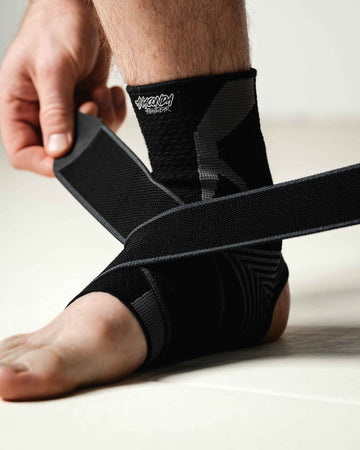



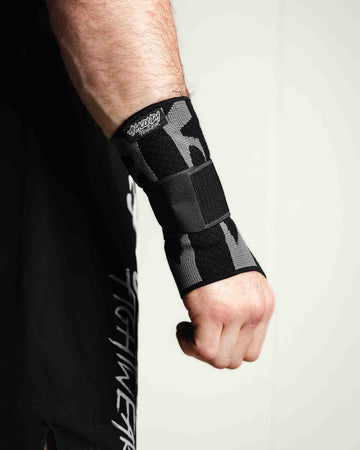

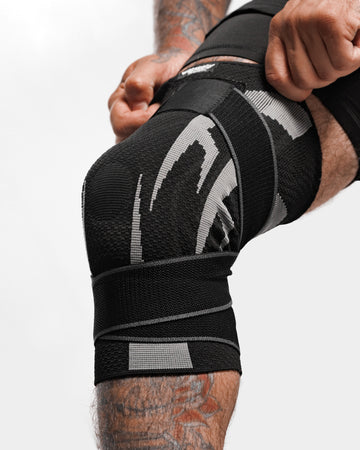



![How Long Does a Knee Injury Take to Heal? [Essential Insights and Tips]](http://anacondafightwear.co/cdn/shop/articles/How_Long_Does_a_Knee_Injury_Take_to_Heal.jpg?v=1764885786&width=533)
